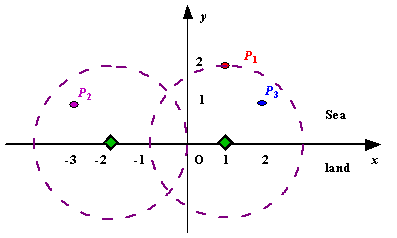POJ1328 Radar Installation(贪心问题)
来源:互联网 发布:河南大学二本专业知乎 编辑:程序博客网 时间:2024/06/07 22:41
Description
We use Cartesian coordinate system, defining the coasting is the x-axis. The sea side is above x-axis, and the land side below. Given the position of each island in the sea, and given the distance of the coverage of the radar installation, your task is to write a program to find the minimal number of radar installations to cover all the islands. Note that the position of an island is represented by its x-y coordinates.

Figure A Sample Input of Radar Installations
Input
The input is terminated by a line containing pair of zeros
Output
Sample Input
3 21 2-3 12 11 20 20 0
Sample Output
Case 1: 2Case 2: 1
好题!真是一道好题啊!这一道题的意思就是说,在x轴上方是海域,下方和x轴都属于陆地。现在给定一些海岛坐标,并且给出雷达可以搜索的长度,要求雷达尽可能覆盖海岛,并且所用雷达数目最少。这道题,一开始想真的觉得好困惑,这咋整?后来慢慢形成思路,我把他们全部按照x轴从小到大排序,从最左边开始贪心,在雷达包含选定的海岛的情况下,尽可能放入更多的海岛。好,这是一个初始方案,接下来写起来就没这么简单咯。对了,雷达肯定是在x轴上的,这样照到的海域肯定会比在x轴下面要大!
问题1,选定第一个海岛之后,他在x轴上有两个交点,然后如果放入第二个海岛,这个交点的范围会一直缩小的,直到其他全部都不能放入这个交点范围内。而我一开始却只保留了右边的交点,因为我是以x轴从小到大排序的嘛,天真的以为只要下一个海岛左交点小于这个右交点就行了,但是发现我左边的交点也是变化的,也需要算出来才行。
问题2,排序的时候还要注意,如果x轴是相同的,那就按照y的大小从大到小排序,这样最上面那个点和x轴的两个交点的范围是相对于下面的点来说是比较窄的,可以减少一下范围的更新次数嘛。。。
问题3,我也是看到别人给的数据才想的,那就是如果真的这么奇葩他的海岛给的y点是小于0的,也就是在陆地上的怎么办,然后就是我一开始是用的m+n来结束while读入循环,然后发现他给我出了这样一组数据,3 -3,三个岛,雷达范围是-3?什么鬼?反正这样也会让我的程序结束,这样的数据我觉得是不合法的,但是他给出来了就改一改吧,毕竟acm本来就是个坑。
然后我自己还有各种各样的粗心大意的错误,TLE了两发,while循环那忘记要j++了。。。RE的两发,这个。。。我也不知道为什么。。。wa了一发,还是太粗心。。。然后,终于终于过了!
代码如下:
#include<cstdio>#include<algorithm>#include<cstring>#include<cmath>using namespace std;int mark[1005];int n, m, ppp;struct node{int x, y;double left,right; bool operator < (const node &a)const{if(x != a.x)return x < a.x;elsereturn y > a.y;}}island[1005]; void func(int i){ppp++;mark[i] = 1;double LEFT = island[i].left, RIGHT = island[i].right;int j = i + 1;while(j < n){if(!mark[j] && ((island[j].left >= LEFT && island[j].left <= RIGHT) || (island[j].right >= LEFT && island[j].right <= RIGHT)|| (island[j].left <= LEFT && island[j].right >= RIGHT))){mark[j] = 1;LEFT = island[j].left > LEFT ? island[j].left : LEFT;RIGHT = island[j].right < RIGHT ? island[j].right : RIGHT;} j++;} }int main(){ int flag, k = 1, i, j; int tx, ty;while(scanf("%d%d", &n, &m), n != 0 || m != 0){memset(mark, 0, sizeof(mark));flag = 0;ppp = 0;for(i = 0, j = 0; i < n; i++){scanf("%d%d", &tx, &ty);if(ty > m)flag = 1;if(ty >= 0 && !flag){island[j].x = tx;island[j].y = ty;island[j].left = 1.0 * tx - sqrt(m * m - ty * ty);island[j].right = 1.0 * tx + sqrt(m * m - ty * ty);j++;}}n = j;printf("Case %d: ", k++);if(flag || m <= 0)printf("-1\n"); else{sort(island, island + n);for(i = 0; i < n; i++){if(!mark[i])func(i); }printf("%d\n", ppp);}}return 0;}看到代码才想起,就是我们判定下一个海岛是否在这个范围内,有三种情况,一种是,下一个海岛的左交点坐标在范围内,一种是右交点在范围内,还有一种!!!就是下一个海岛的左交点小于范围的左交点,右交点大于范围的右交点!相当于下一个海岛的左右范围比原本的范围还要大!这也是有交集的!!!脑子不够用我当时就是少了这种情况啊!!!好像就是因为这个wa了一发。
- POJ1328 Radar Installation(贪心问题)
- POJ1328 Radar Installation 贪心
- POJ1328 Radar Installation 贪心
- 【贪心】POJ1328 Radar Installation
- poj1328 Radar Installation 贪心
- 【POJ1328】Radar Installation 贪心
- POJ1328 Radar Installation 贪心
- 贪心- poj1328 Radar Installation
- POJ1328 Radar Installation 贪心
- poj1328 Radar Installation 贪心
- poj1328 Radar Installation 贪心
- POJ1328 Radar Installation (贪心)
- POJ1328 Radar Installation(贪心)
- POJ1328 Radar Installation(贪心)
- 【贪心】[POJ1328]Radar Installation
- POJ1328-Radar Installation(贪心)
- POJ1328 Radar Installation (区间选点问题,贪心)
- ZOJ1360 POJ1328 Radar Installation, 贪心
- socket/ptrace
- mysql 不是外部内部命令的解决方法(修改环境变量)
- [gtest][001] A quick introduction to the Google C++ Testing Framework
- Fedora安装MysqlWorkbench
- lucene索引源码分析2
- POJ1328 Radar Installation(贪心问题)
- Android--自定义标题栏(TopBar)
- 大二辣
- Android打造ListView和GridView万能适配器
- mysql lock in share mode 和 select for update
- IOS的安全机制
- navicat连接oracle数据库ORA-28547:connection to server failed, probable Oracle Net admin error错误,解决方法
- git 命令大全
- AndroidManifest进修笔记


